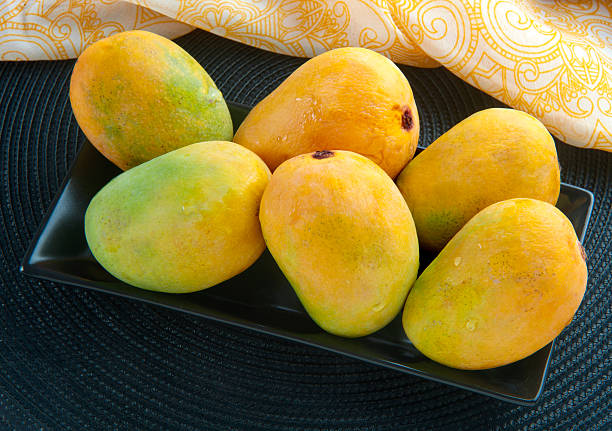Hamsters are the best, and we adore them. Having a pet hamster means we have additional obligations.
We need to feed them, water them, and give them a good cleaning.
However, there are occasions when we wish to pamper them as well, and these treats are typically made from human food.
Is it true that hamsters enjoy mango? Absolutely! Feeding it the right amount of food is your only concern.
Hamsters can be fed mango, and this article will show you how to do so.
We’ll also discuss the several types of mango that are safe for your furry buddy to eat, as well as the potential advantages and disadvantages of doing so.
Enjoy!
What is Mango?
Mangoes, a tropical fruit native to Asia, are prized for their flavor and sweetness.
The green and yellow varieties have been cultivated for thousands of years.
Mangoes are mostly grown in India and China. Because of their sugary flavor, mangos are added to a wide variety of desserts. Incredibly, it can be used in a wide variety of ways!
It’s a reasonable query, given that so many people keep this fruit in their kitchens.
Can Hamsters Eat Mango?
Yes, as we have already emphasized. Mango is safe and tasty for all hamsters, but you’ll want to have plenty on hand.
Be careful, there’s a lot of sugar in this tasty fruit. To ensure the mango’s safety, please follow these steps:
- Wash it – To remove germs and pesticides!
- Keep it plain – With no sauces, or juices!
- Keep it unsweetened: Mango is already very sweet!
- Avoid giving them the stone!
If you follow these precautions, your hamster should be OK eating mango.
Mango Nutritional Facts

Mangoes are low in calories (60 kcal per fruit) and high in beneficial nutrients including vitamin C and folate.
These other nutrients may not be as important to us as vitamin C and protein, but even in trace amounts, they can have an effect on a pet as small as a hamster.
Mangoes are incredibly important due to the high levels of calcium, phosphate, salt, and glucose they contain.
Your pet’s lifespan may be shortened due to diabetes brought on by a diet high in sugar.
- Mangoes are a favorite snack of our Hamsters. Mangoes have a fantastic amount of nutrition, which is outstanding for our Hamsters.
- Mangoes contain vitamin C, which is vital for our hamster’s diet. A shortage of Vitamin C in our hamster’s diet can result in various issues, including scurvy. Vitamin C also aids in wound healing.
- Mangoes also include Vitamin A, Vitamin B-6, and other minerals our Hamsters require. These vitamins aid in the wellness of our children.
- Mangoes contain calcium, which helps to keep our hamster’s bones and teeth strong. On the other hand, excess calcium can generate bladder stones and sludge in our bodies.
How to give your Hamster Mango?

Mango is a great treat for hamsters, but you should always be holding or very close to them when you give them food.
This is due to the fact that sharing tasty snacks with your hamster can help you develop a closer relationship with it and aid in its socialization.
Do a taste test on your hamster with a very small amount to see if they enjoy this fruit.
There’s no point in showering your hamster with stuff if it won’t eat it.
However, it’s possible that your hamster will stuff the treats in their cheek poaches.
Make sure the mango is clean before feeding it to your hamster.
No more stressing over whether or not pesticides or other harmful substances are affecting your pet!
Mango is an excellent addition to your hamster’s diet, which should also include pumpkin seeds, cabbage, and carrots.
Your pet will benefit greatly from these items, but only if they are given to it in the right quantities.
How many mangoes should you feed your hamster?
Mango is safe for hamsters to consume, but you need to give them the proper amount.
It’s true that different hamster species have different dietary needs.
Because of their larger stature, Syrians can consume the most food, while Robos and Dwarfs are limited to ingesting only a tiny fraction of that.
How many mangoes should a Syrian Hamster eat?
It’s true that Syrian hamsters are the biggest of the hamster species. For maximum satiety.
Every week, cut them a piece of mango about the size of an ear. Even though it may not look like much, this much mango can be toxic to your pet.
How many mangoes should a Roborovski hamster eat?
To compensate for their diminutive stature, Robos can only consume a fraction of the Mango that a Syrian can.
Each week, give them a chunk of mango about the size of a paw. All the good effects, none of the negative side effects of overfeeding!
How many mangoes should a Dwarf hamster eat?
Because of their reduced size, dwarf hamsters like the Chinese, Campbell, and Russian varieties can’t eat as much as regular hamsters.
Have them weekly nibble on a little piece of mango ear! Although it’s not much, this will do for now.
Benefits of Mango
We know that hamsters can eat manga, but what are the benefits of this? We want to improve their health, so it’s very important that they eat the right foods.
Mango is good for people in a lot of ways, and the same is true for hamsters.
Some of the good things that can happen when you feed your hamster an appropriate amount of mango are:
- Antioxidants – This benefit your hamster by protecting them against the effects of old age
- Vitamin A – This benefits your hamster’s immune system!
- Vitamin K: This helps your hamster’s blood clot, which helps their wounds heal.
- Vitamin B: This vitamin makes your blood cells work better and makes your hamster healthier.
- Vitamin E: This keeps your hamster’s eyes and skin healthy.
Risks of Mango
The mango is safe for hamsters to eat, but they shouldn’t overdo it.
Thus, there are concerns about them consuming an excessive amount of mango. Examples of such things could be:
- Obesity – Mango has a lot of sugar in it. This can lead to them becoming fat which can lead to further health complications in the future.
- Diabetes – A large amount of sugar in mangos means that it can result in diabetes. This will lead to complications that can lower your hamster’s lifespan.
- Nutritional Deficiencies – If your hamster eats too much mango, they can gain nutritional deficiencies as they won’t be eating their usual hamster food. This is why you need to be careful
- Digestive Issues – Mango has a lot of acidic content which can result in them having stomach problems. They also shouldn’t eat the stone.
Can I Give My Hamster Mango Juice Or Dried Mango?
This appears to be a reasonable inquiry. Since mangoes are so juicy and the juice is so delicious, why not give some to our furry friends on a hot summer day?
This is unfortunately not possible. Hamsters should avoid drinking juice of any kind. It’s high in sugar and low in nutrients.
Since the hamster doesn’t obtain the fiber it would from eating fruit, the sugars in the food aren’t digested as efficiently.
As with fresh mango, dried mango is off-limits. Dried mango, especially in its powdered form, can be too sticky for hamsters to manage, potentially gumming up their lips and cheeks.
Again, hamsters shouldn’t eat it because it likely has sugar added to preserve the mango.
Only fresh mango should be fed to your hamster; anything else, or anything just labeled “mango,” is not a suitable substitute for the real thing.
How To Feed Mango To Hamsters?
Always be hands-on and near to your hamster when feeding it a delicacy like a mango.
Because sharing munchies with your hamster can strengthen your relationship and encourage their socialization.
The best way to find out if your hamster enjoys this fruit is to give it to them in large quantities.
If your hamster is not interested in it, there is no purpose in providing it to them in large quantities.
Alternatively, your hamster might stuff the food into their cheek pouches.
This shouldn’t replace the hamster’s main meal, but rather be offered as a supplement.
Moderate consumption (no more than a tablespoon) once or twice weekly is recommended; overconsumption is not desirable.
When introducing new food to your pet’s diet, take it carefully to avoid upsetting their stomach; if you see any signs of diarrhea, stop feeding them altogether until they’ve recovered.
Don’t give your pet any fresh fruit that you wouldn’t eat yourself.
Take the subsequent steps to make sure the safety of the mango:
- Wash it to get rid of bacteria and pollutants!
- Keep it simple — no sauces or liquids!
- Allow it to be unsweetened: Mangoes are already quite tasty!
- Please don’t give them the stone!






